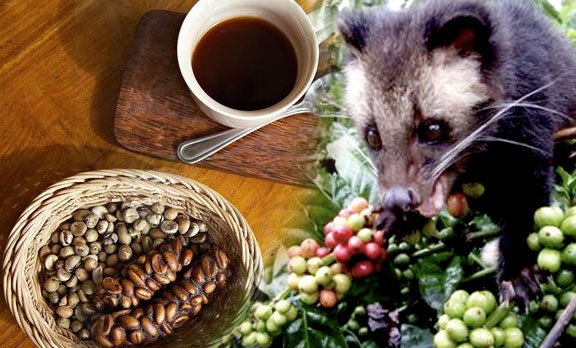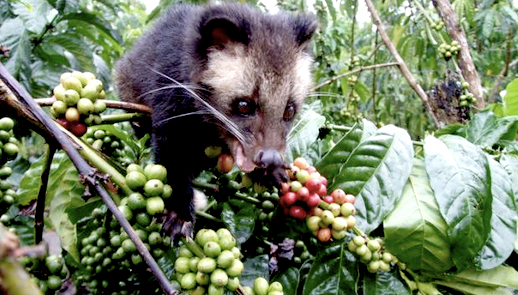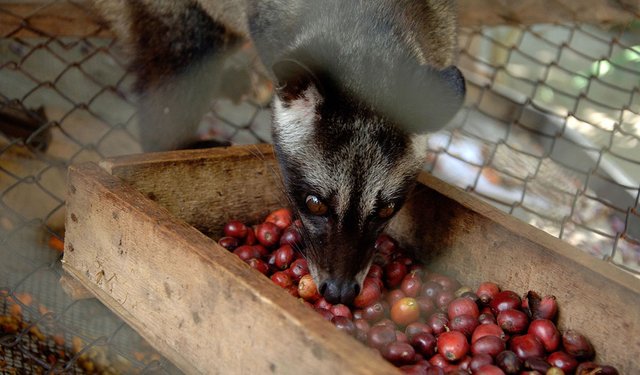Kopi Luwak - The Most Expensive Coffee In The World

Kopi luwak is the world’s most expensive coffee. You must be wondering why? The main factor of it’s high price is the uncommon method of producing such a coffee.
Kopi Luwak produced from the coffee beans which have been digested by a certain Indonesian cat-like animal called then palm civet or also civet cat. Thats why kopi luwak is also called cat poop coffee or civet cat coffee. The feces of this cat will be collected, finished and sold as kopi luwak. The cat, certified kopi luwak producers, the kopi luwak coffee itself and it’s unique properties and taste.
The short supply, in comparison with the high demand, the different taste and the uncommon production methods define the value of kopi luwak. So that was the reason why it becomes the most expensive coffee in the world.
Kopi Luwak become popular culture, In 1995, John Martinez of J. Martinez & Company in Atlanta, Georgia won an Nobel Prize for "Luak Coffee, the world's most expensive coffee, which is made from coffee beans ingested and excreted by the luak, a bobcat-like animal native to Indonesia."
So? what does its taste?
Kopi Luwak taste is unique. Some people might didn't like it. From the wikipedia explanation stated that there were few objective assessments of taste. Kopi luwak is a name for any beans collected from the excrement of civets, hence the taste may vary with the type and origin of beans ingested, processing subsequent to collection, roasting, aging and brewing. The ability of the civet to select its berries, and other aspects of the civet's diet and health may also influence the processing and hence taste.
The Specialty Coffee Association of America (SCAA) states that there is a "general consensus within the industry ... it just tastes bad". A coffee professional cited in the SCAA article was able to compare the same beans with and without the kopi luwak process using a rigorous coffee cupping evaluation. He concluded: "it was apparent that Luwak coffee sold for the story, not superior quality...Using the SCAA cupping scale, the Luwak scored two points below the lowest of the other three coffees. It would appear that the Luwak processing diminishes good acidity and flavor and adds smoothness to the body, which is what many people seem to note as a positive to the coffee.”
Tim Carman, food writer for the Washington Post reviewed kopi luwak available to US consumers and concluded "It tasted just like...Folgers. Stale. Lifeless. Petrified dinosaur droppings steeped in bathtub water. I couldn't finish it."
Some critics claim more generally that kopi luwak is simply bad coffee, purchased for novelty rather than taste. Massimo Marcone, who performed extensive chemical tests on the beans, was unable to conclude if anything about their properties made them superior for purposes of making coffee. He employed several professional coffee tasters (called "cuppers") in a blind taste test. While the cuppers were able to distinguish the kopi luwak as distinct from the other samples, they had nothing remarkable to appraise about it other than it was less acidic and had less body, tasting "thin". Marcone remarked "It's not that people are after that distinct flavor. They are after the rarity of the coffee".
At the bloomberg article, Kopi Luwak mentioned as some of the world's most prized in Java. Already sells more than $600 a pound. Camille Delebecque, a biologist, and Sophie Deterre, a flavor chemist, have spent much of the past year working to replicate the civet’s flavor-altering powers while taking the mammal and its poop out of the equation.
Hystorical
The origin of kopi luwak is closely connected with the history of coffee production in Indonesia. Its begin in the early 18th century while the Dutch established the cash-crop coffee plantations in their colony in the Dutch East Indies islands of Java and Sumatra. Including Arabica coffee introduced from Yemen.
During the era of Cultuurstelsel in 1830-1870, the Dutch prohibited the native farmers and plantation workers from picking coffee fruits for their own use. Still, the native farmers wanted to have a taste of the famed coffee beverage. Soon, the natives learned that certain species of musang or luwak (Asian palm civet) consumed the coffee fruits, yet they left the coffee seeds undigested in their droppings. The natives collected these luwaks' coffee seed droppings, then cleaned, roasted and ground them to make their own coffee beverage. The fame of aromatic civet coffee spread from locals to Dutch plantation owners and soon became their favourite, yet because of its rarity and unusual process, the civet coffee was expensive even during the colonial era.
Kopi Luwak Production
In Indonesia, Sumatra is the world's largest regional producer of kopi luwak. Sumatran civet coffee beans are mostly an early arabica variety cultivated in the Indonesian archipelago since the 17th century. The major Sumatran kopi luwak production area is in Lampung, Bengkulu and Aceh. In other regional has also producing Kopi Luwak, such as, Jawa Barat, and Jawa Timur.
On the Internet, there are a lot of stores who sells Kopi Luwak. So you must be carefull, because a lot of them is not 100% pure kopi luwak. One of the big problem is, kopi luwak probably just around less than 5,000 pounds per year than there is actually produced.
Natural Civet Cats Versus Farmed Civet Cats

Natural Civet Cats
There is a differences between farmed and wild civet cats. Kopi luwak has traditionally consisted of the best quality, ripest coffee cherries the luwak has selected and chosen to eat while leaving the vast majority of presumably inferior cherries uneaten. This is certainly a major factor in the final quality of the kopi luwak produced. Feeding luwaks coffee cherries to the exclusion of other foods will of course ensure they eat the cherries.
However the cherries have not been selected by the luwak and are therefore not of the standard that is produced when the luwak is free to roam a coffee planation. The result is that kopi luwak produced by animals that are caged and farmed is inevitably of lower quality than wild or free range luwaks.

Farmed Civet Cats
Farmed civet palms are kept in a small wooden cell where its job is to eat and defecate. The animals select their berries from bowls instead of bushes. No more roaming the forests for these graceful cat-like creatures; a practice some connoisseurs’ claim leads to beans literally tainted by stress. Due to overfeeding of unripe coffee cherries while captive, the civets become ill. It is evidenced by bloody feces; however, once bleeding occurs, it is often too late to save the creatures.
I upvoted You
Keep up the great work @eb-indonesia
Upvoted
Hi! This post has a Flesch-Kincaid grade level of 9.9 and reading ease of 58%. This puts the writing level on par with Michael Crichton and Mitt Romney.